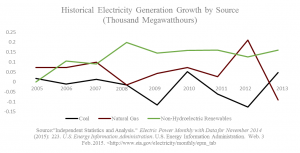SOTU: President Obama’s Reckless Energy Policy
Last night, President Obama gave his final State of the Union (SOTU) address to the nation. He briefly discussed energy policy:
Seven years ago, we made the single biggest investment in clean energy in our history. Here are the results. In fields from Iowa to Texas, wind power is now cheaper than dirtier, conventional power. On rooftops from Arizona to New York, solar is saving Americans tens of millions of dollars a year on their energy bills, and employs more Americans than coal – in jobs that pay better than average. We’re taking steps to give homeowners the freedom to generate and store their own energy – something environmentalists and Tea Partiers have teamed up to support. Meanwhile, we’ve cut our imports of foreign oil by nearly sixty percent, and cut carbon pollution more than any other country on Earth.
Gas under two bucks a gallon ain’t bad, either.
Now we’ve got to accelerate the transition away from dirty energy. Rather than subsidize the past, we should invest in the future – especially in communities that rely on fossil fuels. That’s why I’m going to push to change the way we manage our oil and coal resources, so that they better reflect the costs they impose on taxpayers and our planet. That way, we put money back into those communities and put tens of thousands of Americans to work building a 21st century transportation system.
Seven years ago, President Obama said he would bankrupt the coal industry, he has come pretty close to doing just that. The American coal industry is on the verge of collapse, with around 50 companies out of business and stock prices of the big four companies have fallen as much as 99 percent! Most recently, the second largest coal company has filed Chapter 11 bankruptcy.
In addition to all the regulations placed on the coal industry by the Obama administration, natural gas has experienced a boom due to new discoveries and the advanced technologies of hydraulic fracturing and horizontal drilling. Natural gas recently passed coal as America’s top source of energy power.
Despite the President’s efforts and the natural gas boom, coal is still a major source of American energy power. While, renewable energy is only supplying 6 percent of our electric power.
Wind power and solar power are also not cheap, compared to energy options such as natural gas and coal. The savings that the President is referring to are the very high subsidies that both the federal government and some states have been giving to individuals for buying wind or solar. Also, I am sure he is adding in the possible savings over something like 20 or 50 years. Yet leaving out the very high initial installation and maintenance costs.
The President’s SOTU last night coverage a variety of topics, including the reckless energy policy over the past seven years. An energy policy that has unnecessarily put our coal industry on life support, at a high cost to taxpayers and energy consumers.

